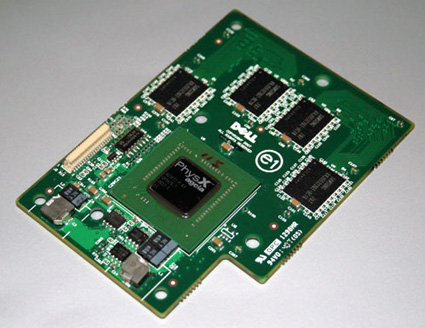Analysis: Nvidia's Ageia Purchase - A Brilliant Move?
The state of physics computing
Back in 2006, ATI and Nvidia started a marketing battle demonstrating GPUs being used for physics processing: ATI used three Radeon X1900XTX cards and Nvidia two 7900 GTX cards to ramp up their physics capability. Both companies were caught on the wrong foot when Intel acquired Havok: Both concepts were utilizing Havok's FX engine, which was "cosmetically affecting physics", according to game developers we talked at that time.
A fully-fledged Havok engine is another ballgame. Even before its acquisition by Intel, Havok signed lots of customer contracts. Overall, there are around 150 Havok game titles, and the company's software was used in several movie productions like The Matrix, Poseidon or Troy.
When it comes to Ageia's PhysX, there were numerous statements and analysis that PhysX was a failure. However, the truth is actually quite the opposite. The PhysX hardware didn't exactly took off in spectacular fashion, but Ageia has been building a market with lucrative OEM deals and H2 2007 certainly was a golden period for the company. Ageia closed several good deals and we should not forget that there was a mobile part that came to life with the help Nvidia's MXM packaging. But, Ageia was aware that PhysX never can have an impact in the game industry it can't get millions of cards into customer hands.
The actual success of Ageia is the PhysX SDK. PhysX is reportedly used in more than 140 game titles developed for Microsoft's Xbox 360, Nintendo's Wii, Sony PlayStation3 consoles and PC platforms. At the time of this writing, there were more than 10.000 active users of the PhysX SDK. Game developers who requested to remain anonymous told us that "PhysX is the best thing that can be utilized on a pathetically under-performing [Xbox 360] PowerPC processor".
Before its acquisition, Ageia made some quiet purchase, including NovodeX and Meqon, two hot property engines. NovodeX was a smart deal since it was chosen by Epic, while Meqon was the brainchild of Swedish developers, then selected for the never ending story of Duke Nuk'em Forever and TimeShift.
With both Havok and PhysX being tied neck-to-neck, it is obvious that computing of physics is at a critical point. Let's have a look.
Get Tom's Hardware's best news and in-depth reviews, straight to your inbox.
